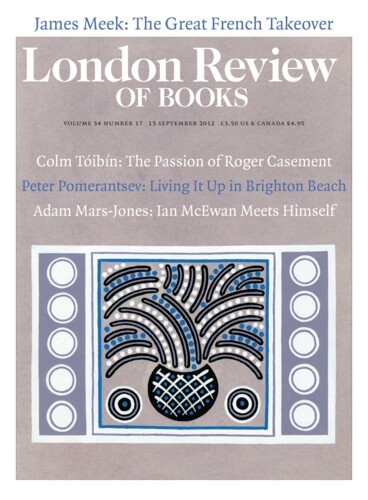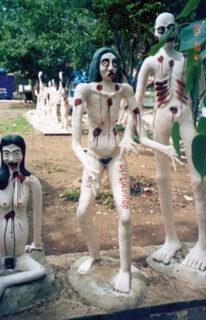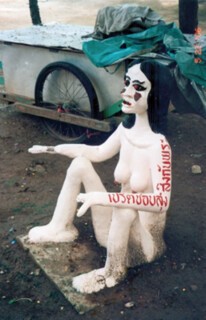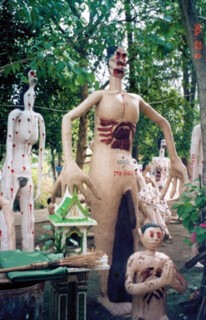In 1975 Benedict Anderson first visited the extensive monastery of Wat Phai Rong Wua, one of dozens in central Thailand; he returned in the 1990s and again a few years ago. Any wat is an imagined community, and this one, a Buddhist Disneyland, presents a special case for Anderson, whose curious book, The Fate of Rural Hell: Asceticism and Desire in Buddhist Thailand, enlivened with startlingly brash photographic evidence, is about currents in the national imagination, about modernity and about forms of religious practice (Seagull, £6). In the abbot’s private museum, for example, next to a skeleton in a vitrine, there used to be a replica of Michelangelo’s David, exposing himself, scarlet Y-fronts fashionably dropped, to show a sea cucumber-like penis quite unlike the original.
Their numbers have now dwindled to a mere million or so, but forty years ago there were many millions of monks in Siam (as Anderson often calls the country), and an abbot enjoyed – still enjoys? – the kind of prestige that Suger of St Denis or Hildegard of Bingen had in the early medieval era. Luang Phor Khom (Venerable Monk Called Khom) was ordained in 1922 and became abbot in this rural backwater in 1936; at the apex of a system of polite slavery and homosocial enclosure, he began a programme of intensive building, with funds chiefly raised by the sale of amulets. The venerable monk wanted his vast monastery to make manifest the international ecumenical character of Siam Buddhism, and he had the backing of a local grandee growing rich on new industry in the area. With the assistance of temple boys, he raised colossal replicas of Japanese buddhas and Indian stupas – one of these statues was intended to be the largest in the whole world. When a visitor informed him that the Buddha of Nara was even bigger, the abbot immediately enplaned to Japan, checked the buddha out, and came back to enlarge his version.
At Alton Towers in the 1980s (I may be misremembering) there were miniatures of the seven wonders of the world, alongside the Eiffel Tower, the Statue of Liberty and Saarinen’s arch in St Louis – and very fascinating they were, intricately modelled and quite embarrassingly enticing in their newfangled dinkiness. Susan Stewart writes about the attraction of the tiny and the gigantic, the souvenir and the collection, in her book On Longing (1984), where she identifies the erection of colossi with the invention of a collective and the miniature with the construction of the personal. But there the resemblances between the nostalgic kitsch of contemporary theme parks and Abbot Khom’s weird creation end. When Anderson returned in 2009, the abbot had been dead 19 years, and David was now gilded all over and covered up in ample boxer shorts.
The wat’s chief appeal – and the fascination of this bizarre opuscule – arose from the zone called Narokphum (‘Hell’), a sculpture garden filled with ‘hungry ghosts’ (praed) with their torments garishly depicted. Each statue or group was personally commissioned by Luang Phor Khom, devised and set up over a long period as the theme-park wat grew and grew. Cast in cheap concrete, whitened with limewash, crudely daubed with household paint, the sinners are tormented by invisible demons; the only devils we see are the praeds themselves, as they are disembowelled, impaled, engorged, twisted, battered, pierced. Bodily tortures such as Bosch dreamed of and monstrous physical excrescences such as disfigure Satan’s minions in scenes of the Temptation of St Anthony, for example, are here represented to similar effect – the praeds’ sufferings look horrific yet are also horribly hilarious. But laughter may be, as Freud said, a defence against horror and pain. The sins the victims have committed are inscribed on their white flesh in red letters. Many are petty and local: stealing fruit from the wat, fishing for turtles in its ponds, looking for sex in the grounds, pickpocketing, flirting with monks. Some come at a personal cost: abortions, drug addiction. The abbot seems mostly to have had the usual thing on his mind, and the crimes he punished so graphically don’t stretch to higher ethics or world anxieties.
There’s one significant and interesting difference from Christian eschatology. A praed isn’t necessarily dead. In some interpretations, Anderson tells us, it’s an individual who’s committed minor offences, and been condemned to a particularly nasty perpetual hunger – for blood and pus – which can’t be satisfied because he or she has only a pinhole for a mouth. This isn’t the case, however, with the victims of the venerable abbot’s fantasies. Their orifices aren’t scanted, and the torments warn that trespasses will lead to suffering now, in much the same way as drug addiction soon tells. Luang Phor Khom explicitly ordered his sculptors to shame the sinners by exposing their all – hence the raucous nudity. So it might have been possible, for example, to meet a lover illicitly in the wat one night and return the following month to find oneself depicted and branded, bloodied and skewered, one’s guts spilling out, breasts lopped off and genitals horribly swollen and luridly aflame. Narokphum is a kind of Struwwelpeter sculpture garden, filled with the dire consequences of bad behaviour come from the mind of a raging celibate.
Dante put some of his enemies in his Inferno while they were still living, but Luang Phor Khom’s unfortunates are ordinary folk. The Chapman Brothers’ diorama of Hell (it was burned in the Momart fire), with its multitude of tiny role-playing figures acting the part of death camp victims and their torturers, comes close to this Thai living hell, though the latter is life-size, clumsy and brash and without a shred of pity. Khom’s temple boys likewise turned for models to Superman and Batman and other figurines, and the more recent praeds have grown muscle-bound, hard-bodied and wasp-waisted – ‘gym rats’, Anderson calls them.
Ogling scenes of horror gives us peculiar pleasure, as Aristotle notes with a kind of puzzlement near the beginning of the Poetics, though he is setting up a distinction between art and reality, saying we like looking at nasty things – at the lowest insects and corpses – when they are represented. (His observation doesn’t altogether hold, unfortunately, as hanging, drawing and quartering used to be a crowd-pleaser.) But the most fascinating effect of the Hell at Wat Phai Rong Wua isn’t the prurience or the laughter or the attention it inspires. The pleasure principle has led to even stranger transformations.
One of the surviving sculptor monks told Anderson how, at the abbot’s orders, he’d carved a gigantic praed of a woman who had many husbands and was always pregnant, and given her a huge cunt. But pilgrims began trying to touch her – and it – for luck. From a horrible green and warty ghoul with a bloated lolling tongue, she became the Golden Goddess, protective deity of the wat, and is now garlanded and arrayed in silk and taffeta. With her Guardian God beside her, she hears the pilgrims’ prayers for a cure, or success in love, or a winning ticket in the lottery. Venerable Old Khom was ‘furious’: the fate of his rural hell was to have become a gateway to paradise. Such are the consequences, one might warn in the abbot’s own finger-wagging style, of attempting to fright people into good behaviour.
Send Letters To:
The Editor
London Review of Books,
28 Little Russell Street
London, WC1A 2HN
letters@lrb.co.uk
Please include name, address, and a telephone number.




